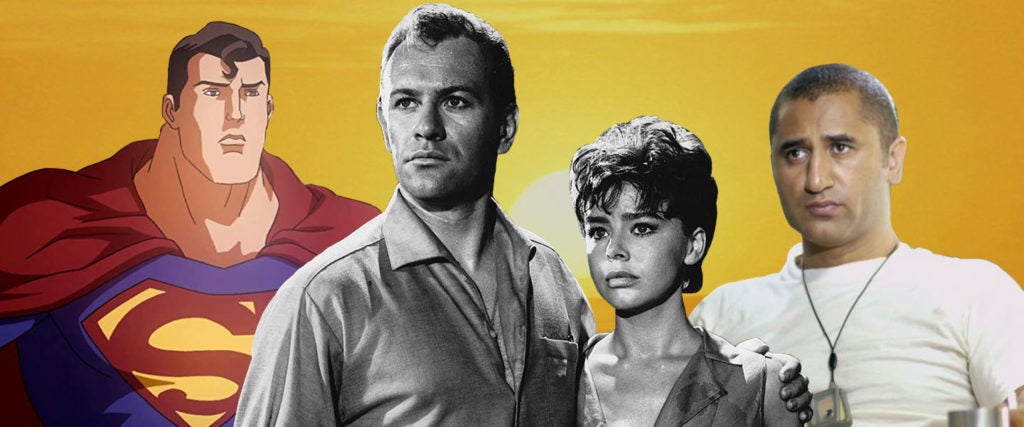Even in this strange, pandemic-warped summer, some things have remained the same. The days are still longer. Annual holidays are arriving right on time. And the sun? The sun is still beating down, forcing even outdoors-y types to tote around sunscreen, sweat towels and water bottles.
As we move into summer’s extra-sweltering second half, we thought we’d take a moment to look back at some movies where the sun isn’t just something in the sky that makes our days more bright, but is instead an environmental force capable of mass destruction. Some of these films are science-fiction, some are horror and some are more down-to-Earth dramas. But in all of them, the characters learn what happens when they take the sun for granted.
The Day the Earth Caught Fire (1961)
Our present-day fears about imminent environmental catastrophe are nothing new, really. Eco-horror has been a popular sub-genre since at least the 1950s, when drive-in theaters were filled with giant ants, rampaging mega-lizards and the like. The British disaster film The Day the Earth Caught Fire aimed to be a little more realistic, imagining what would happen if a series of nuclear weapons accidents shifted the Earth’s orbit, pushing us closer and closer to the sun.
Anyone who’s ever lived through a potentially apocalyptic global crisis — which, right now, is all of us — may be surprised by how familiar a lot of this movie feels. Faced with a slow-moving danger that wreaks havoc in piecemeal ways, the public tries to adjust to the new normal as well as they can… until they can’t. The story is like that old cautionary tale about the frog in boiling water, except the frog is humanity, the pot is the planet and the heat source can’t be switched off.
Sunshine (2007)
Our deadly sun doesn’t always have to be hot. In director Danny Boyle and screenwriter Alex Garland’s cult science-fiction film Sunshine, the sun is gradually fizzling out, and needs a jumpstart from a crew of courageous scientists and astronauts. If they fail, everyone on Earth will freeze to death.
Sunshine is a thoughtful outer-space caper, balancing high-stakes drama with quieter moments of wonder. What’s perhaps most compelling about it, though, is that it turns the sun — a celestial body that in our reality is distant and unapproachable — into a place we can see up close, and even touch. This may be cold comfort (literally), but it’s exciting to imagine that before the sun inevitably dies and takes us with it, we might at last unlock its mysteries.
Gerry (2002)
There are countless movies about people trying to survive being stranded in a desert, but none are quite like Gerry, a spare and strange Gus Van Sant film starring Casey Affleck and Matt Damon as two unnamed best buds (they call each other “Gerry”) who get lost on a routine nature hike. Initially, their screw-up strikes them as just another part of their big adventure. They camp for the night and go with the flow. But one fun night turns into an endless procession of dreary days, suffering the intense heat with no food, water or shade.
There are a lot of things Gerry could be “about” — including exposing the arrogance of shallow young men who are bad at making plans and who don’t have much to say to each other, beyond trading inarticulate insults. But Van Sant (and Affleck and Damon, who are credited as the co-writers of the mostly improvised screenplay) offers more of an experience than a message. What’s it like to trudge through a sand-swept, featureless landscape, under a punishing sun? Gerry lets audiences experience that, step by step and UV ray upon UV ray.
Summer of Sam (1999)
Spike Lee is responsible for writing and directing perhaps the greatest “heat wave” movie of all time: Do the Right Thing. But in Lee’s Summer of Sam, the unrelenting sun doesn’t just steer the action over the course of one day, it affects the actual history of New York City. Set in 1977 — at a time when a decaying NYC was simultaneously celebrating a championship-caliber Yankees team and fearing a serial killer’s reign of terror — the film features an eclectic cast of characters being driven to violence by the life-threatening conditions under which they’re living.
Summer of Sam is ultimately about conflict: punk versus disco, sexual liberation versus reactionary conservatism, neighborhoods versus neighborhoods. But it’s also a story wherein people’s individual plans and identities are derailed by external factors beyond their control. When a power-grid fails — and when the sun turns the asphalt into a giant baking stone — then the entire diverse populace of a city can become one big terrified, overheated, murderous mass.
Vampires (1998)
So far we’ve been talking about the sun as a slow killer, grinding down humans over long periods of time. But what about non-humans? In director John Carpenter’s underrated 1998 action-horror flick Vampires, James Woods and Daniel Baldwin play ruthless monster-slayers, trying to prevent an ancient undead Master from acquiring the artifact he needs to “ascend.” One of their go-to techniques? Just straight-up dragging the vamps into the daylight, where they instantly incinerate.
As a movie, Vampires tells a good story that should’ve been great, had Carpenter and his creative team been given the space to explore the characters and the mythology more. (This is a 108-minute movie that could’ve easily run three hours.) But Vampires still works just fine as a monster picture crossed with a western — a film where the good guys aren’t much better than the bad guys, and where anyone can die at any time. All it takes is an open window shade and a blistering sunbeam to vaporize these villains.
All-Star Superman (2011)
What if the sun wasn’t an inadvertent enemy, but an active one? In the animated adaptation of Grant Morrison and Frank Quitely’s wonderful graphic novel All-Star Superman, the ultimate superhero gets exposed to an overdose of solar energy at the start of the story, and then later learns that the sun itself has been tampered with by Solaris: a supervillain that is, in essence, a sentient artificial sun.
The irony is that Superman’s powers derive from our yellow sun, which charges his Kryptonian body like a battery. But batteries can overcharge, bulging and leaking acid. Even Superman knows that the sun can heal, and the sun can kill.
The Omen (1976)
What’s that? Oh… sun. Not “son.” Never mind. Wrong list.

